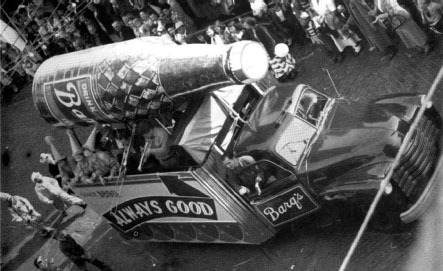Legends and Lore of the Mississippi Golden Gulf Coast (19 page)
Read Legends and Lore of the Mississippi Golden Gulf Coast Online
Authors: Edmond Boudreaux Jr.

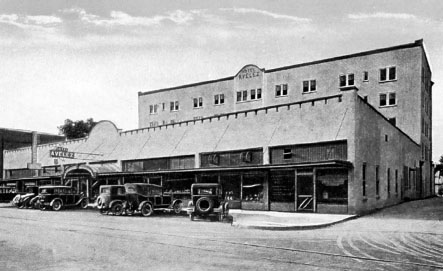
The Avelez Hotel in downtown Biloxi, 1920s.
Courtesy of Alan Santa Cruz Collection
.
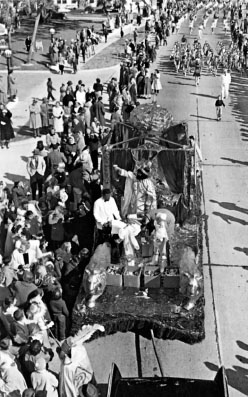
Mardi Gras parade, Biloxi.
Courtesy of Alan Santa Cruz Collection
.
Mrs. Pease began her prizewinning letter by stating, “One of the pleasant features of our winter visit to Beautiful Biloxi was the witnessing of the Mardi Gras carnival celebration.” She noted that New Orleans is the leader in this “southern festivity,” but other cities also host Mardi Gras celebrations.
She described the weather on February 24, 1925, as perfect and said that the crowds began to walk the streets at an early hour. The city's public buildings, stores and streets were decorated in Mardi Gras attire. All that Mardi Gras day, locals in costume walked the streets, some even in masks. Even the little children were “attired in dainty pink and blue dresses with fringe of tiny tinkling bells bordering their skirts, edging their sleeves or dangling from gay sashes.” Young and old, women and men and all walks of life walked about in festive costumes. Evidently, fake green snakes and canes were the articles sold for the 1925 Mardi Gras, according to Mrs. Pease. She noted that, like Christmas, “it comes but once a year and all Biloxi lay aside their cares and sally forth to enter into the Biloxian spirit.”
In the afternoon, the crowd flocked to the beach and piers to witness the water parade. The water parade formed in Back Bay and, about 2:00 p.m., rounded the point and headed west between the beach and Deer Island. Mr. and Mrs. Pease climbed aboard a large oyster boat tied to the pier to witness the water parade. She noted, “We shall never forget the delightful scene with the broad expanse of water with its many sail boats, row boats, skiffs and power boats flitting about.” She describes the sky as rich blue with “fleecy white clouds looking down on a city of sunshine as though pronouncing a Divine benediction on the event.”
The float of King d'Iberville could be seen in the distance as the expectant crowds awaited his arrival. The vessels came nearer and nearer and were escorted by two seaplanes from Pensacola. Besides d'Iberville's royal ship
Fleur de Lys
, there was the battleship
Ixolib, Water Witch
, battleship
Four Sensuous
, Captain Moran's
Riviera of America
, battleship
Sunny South
and many more. While the various vessels tied up to other piers, d'Iberville and his dukes landed at the Yacht Club pier. Here they were met by Grand Marshal W.H. Hunt, who escorted d'Iberville to the king's street float that was a replica of d'Iberville's ship.
The parade began its journey at this point. It consisted of city officials; carnival leaders; and presidents of the Kiwanis, Rotary and Lions Clubs. There were special cars, decorated floats, two bands, Boy Scouts, floats that were advertising various businesses and much more. The parade arrived at the Elks Home, where King d'Iberville drank a toast to Queen Ixolib and Miss June Braun presented the keys to the city to King d'Iberville.
The parade then proceed through the city. A banquet was held at the New Hotel Avelez for the royal party, Gulf Coast mayors and other officials. With the water parade and street parade behind them, another street parade began after dark. Mrs. Pease noted that the “evening ceremonies were more elaborate than those of the afternoon, [with] more participating in the parade.”
She continued, “It is utterly impossible for us to describe the beautiful floats in the evening parade.” She described many of the individual costumes as cows, fish, deer and other animals.
Later that evening, the Queen's Ball was held at the Buena Vista Hotel. King d'Iberville for the 1925 Mardi Gras was Dr. Albert Brown Russ and Queen Ixolib was Miss Josephine Lopez Folkes, the daughter of Dr. and Mrs. H.M. Folkes. Mrs. Pease noted that an estimated twenty thousand individuals had been present to witness the 1925 Biloxi Mardi Gras Carnival.
CHAPTER 29
B
ILOXI
Birthplace of Barq's Root Beer
Most locals are very familiar with Barq's Root Beer. Yet few individuals know that not only is it a local favorite, but it was also created in Biloxi by Edward Barq and was first distributed along Mississippi's Golden Gulf Coast. Often referred to as Barq's Root Beer (even though it contains other ingredients, like caffeine, not found in standard root beer), its unique flavor makes it stand apart from any other root beer. All that can be said is that it is Barq's, not just root beer. Despite Hurricane Katrina, the original Barq's Bottling Works building is still standing at 140 Keller Avenue, just south of Howard Avenue. Next to the historical building is a State of Mississippi Historical Marker that proclaims:
Birth Place of Barq's: Barq's root beer was created by Edward C. Barq Sr. in 1898 and produced on this site until 1936 when the operation was moved to Lameuse Street. A Mississippi Gulf Coast favorite, the number of franchise bottlers grew to 200 by 1950. Acquired by Coca Cola Company in 1995
.
The creator of Barq's, Edward Barq, was listed on his birth certificate as Edward Charles Edmond Barq. He was born in the French Quarter of New Orleans on March 4, 1871. His mother was listed as Maria Gevrgina Savonniere, born in Paris in 1842, and his father was Jules Auguste Barq. His father was an attorney who processed Civil War claims, and his mother was a piano teacher. Jules Auguste was born in Rouen, France, and died on March 16, 1873, in New Orleans at forty-three years of age. He died at the corner of Rampart and St. Louis of Ascites. His death certificate listed the cause of death as dropsy of the peritoneum. He is buried in St. Louis cemetery #2 in New Orleans.
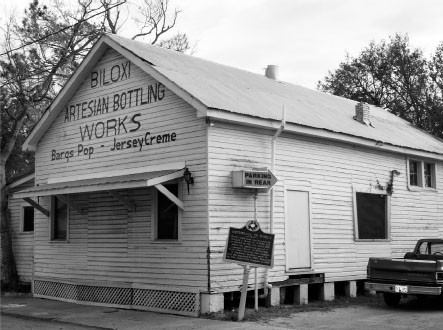
The birthplace of Barq's on Keller Street in Biloxi.
Edmond Boudreaux
.
Edward Barq Sr. was one of four children, with the others being Gaston, Eugenie and Jules. When he was two years old, his mother moved the family to Nice, France. In France, in order to support her family, Maria Barq taught the children of wealthy Americans. When Edward was seven years old, the family returned to New Orleans.
About 1884, when Edward was thirteen, Maria Barq once again moved the family to France. In France, they lived in Paris, but Edward spent much time in the Bordeaux region. While in France, Edward and his brother Gaston began to study sugar chemistry at the University of Paris. He became interested in the science and art of making flavoring extracts.
About 1890, Gaston and Edward returned to New Orleans, where they opened Barq's Brothers Bottling Company. Barq's Brothers bottled carbonated water and its own formulated citrus-flavored drinks. Edward and Gaston bottled soft drinks in New Orleans until Gaston's death about 1892. While in New Orleans, Edward Barq Sr. formulated an orange drink, called Orangine, which won a gold medal at the 1893 World's Fair in Chicago. A few years later, Edward and his brother Jules enrolled in college at Tulane University in New Orleans. But Edward never lost interest in creating flavored extracts and tinkering with soft drink formulas. The late 1800s and early 1900s would soon change Edward Barq's life.
In 1897, he married Ellodie Graugnard, who was born in New Orleans on December 14, 1882. After his marriage, he got a job with a sugar refinery. On weekends, Barq and his wife would journey to the Mississippi Gulf Coast. In 1898, he moved to Biloxi with his wife. Here he started Biloxi Artesian Bottling Works, an extracts and bottling business on a small scale. He would work the bottling business during the summer months and work at the sugar refinery in Louisiana during the winter months. After a year or so, he began to operate the Biloxi Artesian Bottling Works full time. The bottling works primarily bottled citrus-flavored drinks.
Ellodie Barq helped her husband bottle soft drinks during the day and hand-washed the bottles at night. They used a mule-drawn wagon to distribute the bottled drinks to local stores, parlors and restaurants. Edward also bottled Coca-Cola for several years under a subcontract with Bellingrath Coca-Cola Bottling Co., Mobile, Alabama. When he could not purchase the Biloxi territory, he tried to create a formula of his own version of cola called Nervine, but it was not successful.
It was Edward's creation of a root beer with its own distinct flavor that brought him success. Sometime between 1898 and 1900, his new drink, simply known as “Barq's,” was bottled and became a local favorite. Root beer of this time contained herbs, berries and roots of various plants, including sarsaparilla roots. Barq's sarsaparilla-based creation contained less sugar and more carbonation than other root beer drinks. Unlike other root beer of this time, Barq's contained caffeine. Edward Barq never referred to his creation as a root beerâsimply Barq's.
In 1900, Mrs. Barq gave birth to Edward Barq Jr., the couple's only child. The Barq family also raised Jesse Robinson like a son after the death of his parents. Jesse later headed the New Orleans branch of Barq. Edward Barq opened his second plant, Barq's Bottling Works, in Gulfport in 1902. About 1907, Mr. Hartner partnered with Edward Barq, but the partnership was short-lived. Around 1910, the partnership fell apart, and the Gulfport bottling plant was closed.
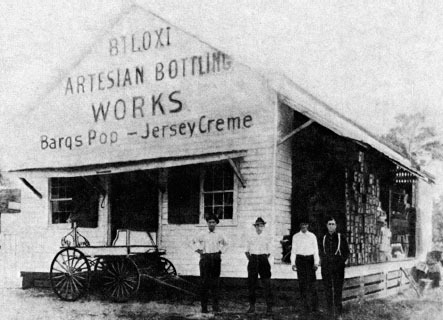
Biloxi Artesian Bottling Works, Edward Barq, proprietor.
Courtesy of Maritime & Seafood Industry Museum
.
